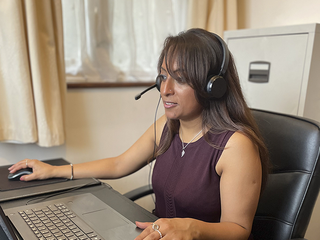Hairy cell leukaemia symptoms and diagnosis
The symptoms of hairy cell leukaemia are caused by abnormal white blood cells which don't work properly, and stop the body making enough red blood cells and platelets.
Common symptoms
Hairy cell leukaemia is a slow-growing blood cancer, meaning that symptoms can be quite mild.
Some people have no symptoms at all, and hairy cell leukaemia is found through a routine blood test for something else. Over time, symptoms can start to build up, but most people can still go about their daily lives.
When you have hairy cell leukaemia, your body produces abnormal white blood cells. These faulty cells (hairy cells) can't do the jobs that normal white blood cells do. Hairy cells also build up in the body, making it harder for your body to grow other normal blood cells like healthy red blood cells and platelets.
This means that as well as having faulty white blood cells that can't fight off infections, your body might also not have enough red blood cells (which carry oxygen around the body) or platelets (which prevent bleeding).
This lack of healthy blood cells is what causes the symptoms of hairy cell leukaemia.
Symptoms of hairy cell leukaemia include:
- anaemia, which can make you feel breathless, tired or dizzy (caused by a low red blood cell count)
- bleeding or bruising easily (caused by a low platelet count)
- infections (caused by a lack of healthy white blood cells, including neutrophils, monocytes and lymphocytes)
- swollen or painful abdomen (tummy area), caused by an enlarged spleen. The spleen is an organ in the upper left side of the abdomen. Hairy cells can build up in the spleen and cause it to swell.
- swollen lymph nodes (glands), caused by a build-up of hairy cells inside the lymph nodes.
- weight loss, tiredness, low energy and generally feeling unwell. These symptoms may be caused by the body spending more energy producing large numbers of abnormal white blood cells.

Tests to diagnose hairy cell leukaemia
If your GP suspects you might have blood cancer, there are a range of tests they can use to investigate. They will also refer you to a haematologist (a doctor that specialises in blood cancers), who can interpret the test results and confirm any diagnosis.
Some people are diagnosed with hairy cell leukaemia by chance, after having a blood test for some other reason. This can happen because hairy cell leukaemia is a slow-growing blood cancer, so you may not have any symptoms. This can come as a big shock.
Other people are diagnosed after going to their GP with symptoms and having tests to find out what’s causing them.
For hairy cell leukaemia, the main tests include:
Your doctor will need to run some blood tests. A sample of blood will be taken from your arm and sent to a lab for testing.
You will probably have a "full blood count". This means looking at the levels of different blood cells in your blood (red blood cells, platelets, and different types of white blood cells).
If a full blood count shows you might have hairy cell leukaemia, you’ll need more tests to confirm the diagnosis.
Blood tests are also used to monitor hairy cell leukaemia after diagnosis.
Bone marrow is a soft, spongy tissue found in the centre of large bones. It is where the body makes its blood cells.
A bone marrow biopsy involves removing a sample of bone marrow from your hip bone. The sample will then be looked at under a microscope, where specialists will check for hairy cells and normal healthy cells.
Some people find the bone marrow biopsy painful, and others don’t. You can ask for pain relief before the procedure.
It normally takes 1-2 weeks to get the results of a bone marrow biopsy.
People who are diagnosed with hairy cell leukaemia may also have a bone marrow biopsy after treatment, so doctors can see how effective the treatment has been.
We have more information about bone marrow biopsies.
Some people may also have a lymph node biopsy. Lymph nodes are glands that are part of your lymphatic system. They are found around the neck, armpit, groin and some other areas.
A lymph node biopsy involves having a small operation under anaesthetic, where a sample of lymph node is taken to be looked at under a microscope, helping to identify any hairy cells in your nodes.
You might have a series of scans as part of getting diagnosed. You might also have scans throughout your treatment to check progress. The most common scans include:
- Ultrasound – An ultrasound scan uses sound waves to produce images on a screen. You might have an ultrasound scan to look at your spleen, or sometimes liver, to detect whether the organ is enlarged.
- CT scan – A CT scan is used to look at your spleen or lymph nodes to detect whether they are bigger than usual. It is completed by a radiographer and uses X-rays to take detailed pictures inside of your body.
Your doctor may also examine your general health and fitness. As well as asking questions about how you feel day to day, they might feel your spleen and lymph nodes to detect whether they are bigger than normal.

Worried about anything or have questions?
If you need someone to talk to, please don't hesitate to contact our Support Service by phone or email.
